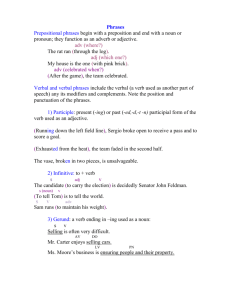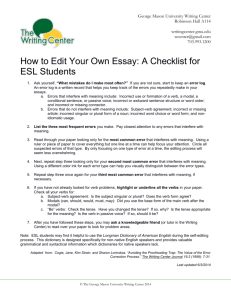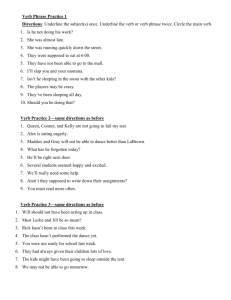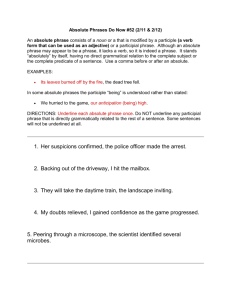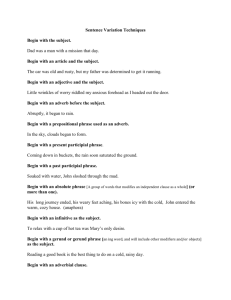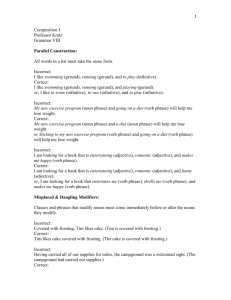Key to corrections
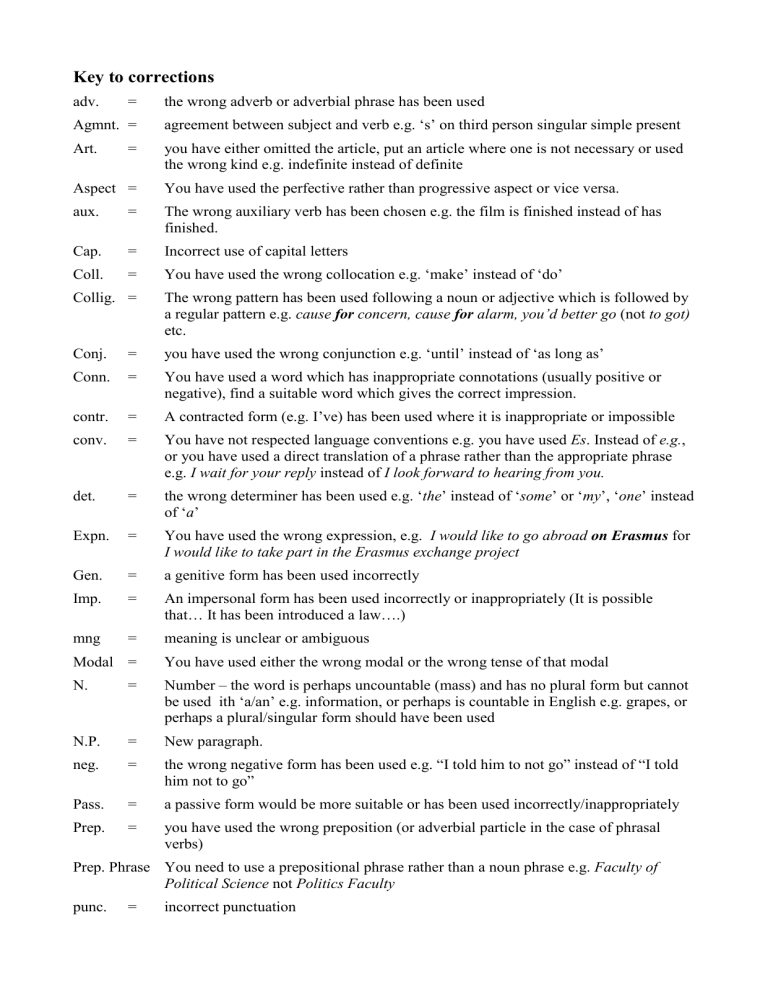
Key to corrections
adv. = the wrong adverb or adverbial phrase has been used
Agmnt. = agreement between subject and verb e.g. ‘s’ on third person singular simple present
Art. = you have either omitted the article, put an article where one is not necessary or used the wrong kind e.g. indefinite instead of definite
Aspect = You have used the perfective rather than progressive aspect or vice versa. aux. = The wrong auxiliary verb has been chosen e.g. the film is finished instead of has finished.
Cap. = Incorrect use of capital letters
Coll. =
You have used the wrong collocation e.g. ‘make’ instead of ‘do’
Collig. = The wrong pattern has been used following a noun or adjective which is followed by a regular pattern e.g. cause for concern, cause for alarm, you’d better go (not to got) etc.
Conj. = you have used the wrong conjunction e.g. ‘until’ instead of ‘as long as’
Conn. = You have used a word which has inappropriate connotations (usually positive or negative), find a suitable word which gives the correct impression. contr. =
A contracted form (e.g. I’ve) has been used where it is inappropriate or impossible conv. = You have not respected language conventions e.g. you have used Es . Instead of e.g.
, or you have used a direct translation of a phrase rather than the appropriate phrase e.g. I wait for your reply instead of I look forward to hearing from you. det. = the wrong determiner has been used e.g. ‘ the
’ instead of ‘ some
’ or ‘ my
’, ‘ one
’ instead of ‘ a
’
Expn. = You have used the wrong expression, e.g. I would like to go abroad on Erasmus for
I would like to take part in the Erasmus exchange project
Gen. = a genitive form has been used incorrectly
Imp. = An impersonal form has been used incorrectly or inappropriately (It is possible that… It has been introduced a law….) mng = meaning is unclear or ambiguous
Modal = You have used either the wrong modal or the wrong tense of that modal
N. = Number – the word is perhaps uncountable (mass) and has no plural form but cannot be used ith ‘a/an’ e.g. information, or perhaps is countable in English e.g. grapes, or perhaps a plural/singular form should have been used
N.P. = New paragraph. neg. = the wrong negative form has been used e.g. “I told him to not go” instead of “I told him not to go”
Pass. = a passive form would be more suitable or has been used incorrectly/inappropriately
Prep. = you have used the wrong preposition (or adverbial particle in the case of phrasal verbs)
Prep. Phrase You need to use a prepositional phrase rather than a noun phrase e.g. Faculty of
Political Science not Politics Faculty punc. = incorrect punctuation
pron. = the wrong pronoun has been used reg. = an inappropriate register has been used e.g. “Shut up!” rather than “Please, be quiet.”
S = subject – the subject of the verb has either been ommitted, does not concord with the verb, or is incorrect
Sp. = a word is spelt incorrectly
T = wrong tense e.g. you have used the present perfect instead of the past simple.
Vb. patt. =
Verb pattern some verbs are followed by the “ing” form, some by an infinitive, some by a finite verb construction e.g. I hate gett ing up early, I want to go , I hope I can come
W. form a wrong word form has been used ‘hardly’ instead of ‘hard’ or ‘real’ instead of
‘really’, embarrassing instead of embarrassed
W.O. = the words of a whole phrase or sentence are in the incorrect order
WW = wrong word – you have chosen the wrong word where there is more than one possibility e.g. ‘pretend’ instead of ‘expect’
= the two words are in the wrong order (or sometimes )
= the choice or word(s) is not incorrect but a more suitable alternative can be found / the structure is awkward/clumsy
= Something has been omitted



